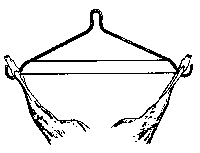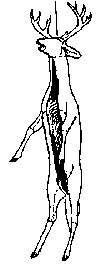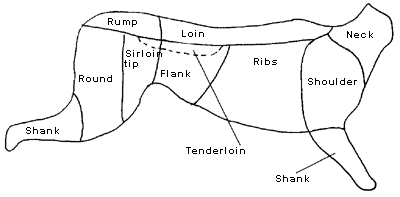by D.E. Benson 1 (6/2010)
Quick Facts…
- If weather is cold, postpone skinning until immediately prior to butchering.
- Small animals may be made entirely into ground meat; large animals may be made into steaks, roasts and other cuts.
- Quick freeze meat at 0 degrees F after wrapping for the freezer and eat within six months for best quality.
 |
| Figure 1. |
 |
| Figure 2. |
The decision to cut up a big game animal yourself or pay a professional butcher
can be a difficult decision, especially for the novice. Locker plants
have the advantage of cold-storage facilities for cooling and aging the
carcass.
An unheated garage, porch or shed, where the carcass can hang in cool weather (near freezing or below at night), is required for home aging. Aging can be omitted, but the result is a slight loss in tenderness.
The advantages of butchering a big game carcass yourself include: saving money; cutting, wrapping and labeling exactly as desired; and learning more about the anatomy and condition of the animal. Expect to spend one or two evenings skinning, cutting and wrapping the carcass.
Equipment
Required equipment for butchering meat includes: a sharp knife (sharpening
stone and steel), freezer wrapping paper, freezer tape, marking pen, a
large cutting board, two containers (for bones and meat scraps, and for
burger or stew meat) and a butcher saw. For the containers, a plastic
pail, roaster, or cardboard box lined with freezer wrapper work well.
Skinning
If cold weather allows, postpone skinning until immediately prior to butchering. The hide will help keep the meat moist and clean. Hang the carcass either by the hocks (Figure 1) or head (Figure 2) for ease and cleanliness during the skinning process. Cut the skin around the neck just below the head and around each leg above the hoof, then up the inside of each leg to the center cut, as shown in Figure 2.
Working from top to bottom, separate the hide from the carcass. Leave as much fat, connective tissue and muscle fibers with the carcass as possible. Avoid getting hair and dirt on the carcass or cutting holes in the hide.
Trimming and Cutting
Remove the head by cutting through the muscles between the skull and the first neck vertebra, then twist the head off.
Remove the meatless lower legs with a saw or cut through the ligaments and cartilage at joints and twist them off.
Cutting can be simple or complex. Many hunters cut all the meat off the skeleton and grind it for hamburger, sausage, salami, etc. Others use the boneless meat for jerky or stew meat, or cut up a big game carcass and make several kinds of steaks and roasts, ribs and hamburger.
the decision on how to cut up a big game carcass should be based on the family’s preferences for meats and to some extent on the size of the carcass. For example, if it is a small antelope or deer and the family uses ground meat frequently, grind most of the meat. On the other hand, a large elk or moose can be processed into a variety of cuts to avoid boredom on the menu. (Table 1 shows estimates of the expected yield and losses from some typical big game animals.)
Yields and losses vary, depending on the size of the animal and where it was shot. An animal shot in the head will have a higher yield than average, while an animal with single or multiple wounds in the leg, shoulder or loin will have a lower yield. Also, a carcass butchered without aging or with less than two weeks of aging will have proportionately higher yields.
The following procedures provide a variety of cuts, including steaks, roasts and ground meat. this procedure assumes that the carcass is hanging by its hocks, the most standard position. If the carcass is hanging by its head or laying on a table, the method can be changed accordingly.
 |
| Figure 3. |
Work with one part of the carcass at a time and leave the rest of the carcass hanging in a cool location. (See Figure 3.)
Remove one of the front legs and shoulders from the rib cage. No saw is necessary. Separate the muscles of the shoulder and make into steaks or roasts. the shank can be ground or cut for stew meat. Remove the other front leg and shoulder and treat it in a similar fashion.
Trim as much meat as possible from the neck. It makes excellent mincemeat, stew or ground meat. Remove the boneless flanks by cutting along the last rib down to the loin, then along the leg. this can be used for ground meat or jerky. On larger animals, this portion is thick enough to be used as a steak.
Next, remove each loin. Cut along the entire length of the backbone next to the dorsal spine. then cut along the lateral spines of the backbone the length of the backbone. Sever the loin where it is still attached at the small of the back. Remove the loosely attached meat near the neck end of the loin. this meat is good for stews, ground meat or other uses, but distracts from the tenderness of steaks. the loin is most suitable for steak. Cut crosswise 3/4- to 1-inch thick for steak. You could also cut into large sausage-like pieces about 8 inches long or into whatever size you wish to cook. Cooking the whole chunk reduces surface area and increases moisture retention.
 |
| Figure 4. |
On loins from smaller animals, such as deer, make longer sausage-like pieces that are cut into portions after cooking or butterfly steaks by cutting sections about 2 inches thick, then cutting those almost in half but leaving enough connective tissue to hold both halves together, as shown in Figure 4.
Cut off the meat on and between the ribs and use it as ground meat or jerky. To prepare ribs for barbecuing, saw the ribs into 5 to 7-inch pieces. Cut into widths, usually two to four ribs wide, depending on the size of the animal. Ribs also can be cut into shorter pieces and used in stew.
The tenderloin is a small muscle connected to the under side of the backbone just in front of the pelvic area. Cut it from the backbone. It, along with the loin, is one of the most tender pieces of meat and most suitable for steaks. Tenderloin from deer-sized big game can be cooked whole. Larger tenderloins may be cut in lengths or made into butterfly steaks as previously described. Many hunters who age their carcasses remove the tenderloins early to avoid drying.
Remove the backbone just in front of the hind legs. Separate the two hind legs by sawing through the middle of the backbone. Remove the rump roast by cutting off the upper end of the leg as shown (Figure 3). this cut should go through the ball and socket joint.
The sirloin tip is the football-shaped muscle at the front of the hind leg. Remove it next. It makes an excellent roast. Separate the large muscle of the round (upper part) of the leg. these can either be cooked whole as roasts or cut into steaks.
The shank of the hind leg, like that of the foreleg, contains considerable connective tissue and probably is best for ground or stew meat. the bone remaining also can be used. the backbone can be cut into sections and used in making soup. Bones also may be used as dog food.
Ground Meat and Jerky
If a meat grinder is not available, many commercial locker plants will grind meat. Big game meat is not nearly as fat as beef and most people find it desirable to add about 20 percent beef suet. For making breakfast sausage, add 30 to 35 percent pork fat.
In addition to using the ground meat for breakfast sausage and hamburger, there are several other tasty items one can make with the ground meat. Many locker plants make excellent salami by using big game meat. It is often available as Polish, Italian or German sausage.
Jerky is another taste treat. A few locker plants will prepare it, although it’s a simple process and can easily be made at home.
Wrapping, Labeling and Freezing
All fat should be trimmed off meat before wrapping. Meat should be wrapped in special freezer wrapping paper designed for that purpose. It can be purchased at most grocery stores. Double wrapping is recommended if meat is to be frozen for several months. Steaks can be divided with two pieces of freezer paper between to allow easy separation prior to thawing.
All packages should be labeled as to contents and date. Knowing the contents will be useful in evaluating cutting procedures. Be precise in labeling. Loin steaks should be labeled differently that round steaks, for example. Dating is particularly important if there is more than one carcass in the same storage unit or if meat is stored for a long period of time.
After wrapping, packages should be quick frozen at 0 degrees F or colder. Packages should be spread out on freezer shelves until frozen solid, after which they may be stacked or placed in freezer drawers. Meat should be eaten within six months.
| Table 1: Average yields and weight losses from various big game animals. | ||||||||
| Field dressed weight* | Losses | Cutting and trimming | Packaged cuts with bone left in leg, loin, rib and shoulder cuts | Packaged cuts without bones | Packaged cuts without bones (% of field dressed weight) | |||
| Head | Skin | Aging | ||||||
| Antelope, male | 77 | 7 | 6 | 7 | 13 | 44 | 36 | 47 |
| Antelope, female | 69 | 5 | 5 | 7 | 13 | 39 | 32 | 47 |
| Mule deer, male | 114 | 8 | 9 | 5 | 25 | 66 | 55 | 48 |
| Mule deer, female | 93 | 6 | 8 | 6 | 21 | 53 | 44 | 48 |
| Elk, male | 437 | 39 | 34 | 14 | 114 | 236 | 188 | 43 |
| Elk, female | 339 | 19 | 26 | 12 | 87 | 195 | 159 | 47 |
| Source: Agricultural Experiment Station, University of Wyoming. *Weight includes eviscerated carcass with head and hide, but with legs cut off at lower knees and hocks. To convert to metrics, use the following conversions: 1 pound = .45 kilograms. |
||||||||
1Colorado State University Extension specialist and professor, fishery and wildlife biology. 11/98. Reviewed 6/2010.
Go to top of this page.





